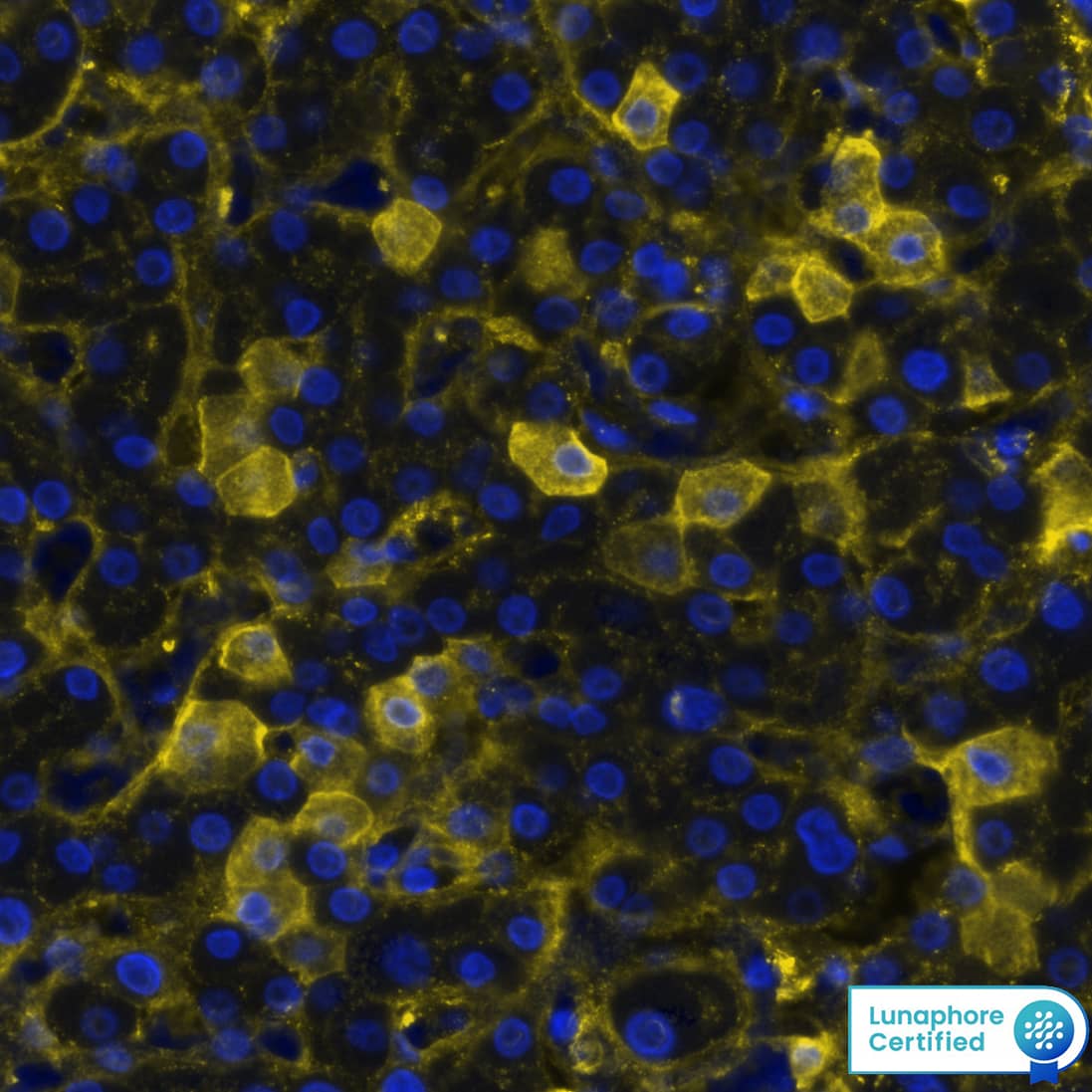Human Fibrinogen A Antibody Summary
Accession # P02671
*Small pack size (-SP) is supplied either lyophilized or as a 0.2 µm filtered solution in PBS.
Applications
Please Note: Optimal dilutions should be determined by each laboratory for each application. General Protocols are available in the Technical Information section on our website.
Scientific Data
 View Larger
View Larger
Detection of Fibrinogen A in human Liver via seqIF™ staining on COMET™ Fibrinogen A was detected in immersion fixed paraffin-embedded sections of human Liver using Mouse Anti-human Fibrinogen A, Monoclonal Antibody (Catalog # MAB9898) at 10ug/mL at 37°Celsius for 4 minutes. Before incubation with the primary antibody, tissue underwent an all-in-one dewaxing and antigen retrieval preprocessing using PreTreatment Module (PT Module) and Dewax and HIER Buffer H (pH 9; Epredia Catalog # TA-999-DHBH). Tissue was stained using the Alexa Fluor™ 647 Goat anti-Mouse IgG Secondary Antibody at 1:200 at 37 ° Celsius for 2 minutes. (Yellow; Lunaphore Catalog # DR647MS) and counterstained with DAPI (blue; Lunaphore Catalog # DR100). Specific staining was localized to the cytoplasm. Protocol available in COMET™ Panel Builder.
 View Larger
View Larger
Detection of Human Fibrinogen A by Western Blot. Western blot shows human serum (negative control) and human plasma. PVDF membrane was probed with 1 µg/mL of Mouse Anti-Human Fibrinogen A Monoclonal Antibody (Catalog # MAB9898) followed by HRP-conjugated Anti-Mouse IgG Secondary Antibody (Catalog # HAF018). A specific band was detected for Fibrinogen A at approximately 70 kDa (as indicated). This experiment was conducted under reducing conditions and using Immunoblot Buffer Group 1.
 View Larger
View Larger
Fibrinogen A in Human Liver. Fibrinogen A was detected in immersion fixed paraffin-embedded sections of human liver using Mouse Anti-Human Fibrinogen A Monoclonal Antibody (Catalog # MAB9898) at 5 µg/mL for 1 hour at room temperature followed by incubation with the Anti-Mouse IgG VisUCyte™ HRP Polymer Antibody (Catalog # VC001). Before incubation with the primary antibody, tissue was subjected to heat-induced epitope retrieval using Antigen Retrieval Reagent-Basic (Catalog # CTS013). Tissue was stained using DAB (brown) and counterstained with hematoxylin (blue). Specific staining was localized to cytoplasm in hepatocytes. View our protocol for IHC Staining with VisUCyte HRP Polymer Detection Reagents.
Reconstitution Calculator
Preparation and Storage
- 12 months from date of receipt, -20 to -70 °C as supplied.
- 1 month, 2 to 8 °C under sterile conditions after reconstitution.
- 6 months, -20 to -70 °C under sterile conditions after reconstitution.
Background: Fibrinogen A
Fibrinogen is a 340 kDa, secreted glycoprotein complex that is found in blood at concentrations of 150-400 mg/dL. It is secreted primarily by hepatocytes, but is also reported to be expressed by fibroblasts, type I alveolar epithelium, intestinal epithelium and some tumor cells. Fibrinogen is a homodimer that is composed of two, three-polypeptide chain subunits. In human, each subunit contains one 847amino acid (aa) alpha chain, one 461 aa beta chain, and one 427 aa gamma chain. Multiple interchain disulfide bonds link all three polypeptides. Fibrinogen plays a central role in clot formation. Conversion of fibrinogen to fibrin is triggered by thrombin, which cleaves fibrinopeptides A and B from alpha and beta chains, and thus exposes the N-terminal polymerization sites responsible for the formation of the soft clot. The soft clot is converted into the hard clot by factor XIIIA which catalyzes the epsilon-(gamma-glutamyl)lysine cross-linking between gamma chains (stronger) and between alpha chains (weaker) of different monomers. Fibrinogen is also a component of the ECM and binds to cell surface molecules on inflammatory cells. Mature human alpha, beta and gamma -chains share 67%, 85% and 83% aa identity with mouse alpha, beta and gamma -chains, respectively.
Product Datasheets
FAQs
No product specific FAQs exist for this product, however you may
View all Antibody FAQsReviews for Human Fibrinogen A Antibody
There are currently no reviews for this product. Be the first to review Human Fibrinogen A Antibody and earn rewards!
Have you used Human Fibrinogen A Antibody?
Submit a review and receive an Amazon gift card.
$25/€18/£15/$25CAN/¥75 Yuan/¥2500 Yen for a review with an image
$10/€7/£6/$10 CAD/¥70 Yuan/¥1110 Yen for a review without an image
